The Real Sheep
Air Date: Week of October 28, 2005
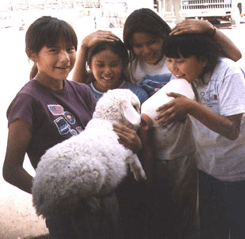
Dine' girls feeding orphan lamb on Black Mesa. (Photo: C.S. Halberstadt, ©2003-2005 Black Mesa Weavers for Life and Land)
There’s an expression among Navajo people in the Four Corners area of the southwest—“sheep is life.” The sheep the Navajo first raised were called churro. They were brought over by Spanish conquistadors in the late 1500s, the first domestic sheep in North America. By the 1930s they were nearly wiped out by the federal government’s campaign against overgrazing on the Navajo reservation. But now, they’ve made a comeback. From Arizona Public Radio, Daniel Kraker tells the remarkable survival story of the Navajo-churro sheep.
Transcript
CURWOOD: There’s an expression among Navajo people in the Four Corners area of the Southwest--“sheep is life.” It reflects the central role the livestock have played for centuries in Navajo commerce and culture.
The sheep the Navajo first raised were called churro. They were brought over by Spanish conquistadors in the late 1500s, and were probably the first domestic sheep in North America. By the 1930s, they were nearly wiped out by the federal government’s campaign against overgrazing on the Navajo reservation. But now, they’ve made a comeback. From Arizona Public Radio, Daniel Kraker reports.
[SHEEP BLEATING; BELLS CLANGING; CORRAL SOUND]
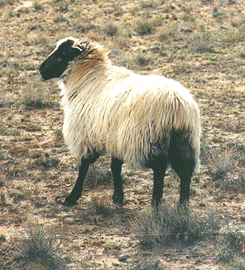
A churro ewe called Penelope. (Photo: J. Begay, ©2003-2005 Black Mesa Weavers for Life and Land.)
[SOUND OF GATE OPENING; MORE ‘BAAAS’; SHEEP SCURRYING ABOUT]
KRAKER: Begay opens the gate and wades into the mass of hooves and horns.
BEGAY: Every time you come to the sheep corral, you’re supposed to have good thoughts and good feelings, and whatever you’re feeling the sheep will know.
KRAKER: He expertly snags a sheep with his shepherd’s cane.
[SOUND OF GATE CLOSING]
KRAKER: Outside the corral, Begay gently lays the sheep on the earth. He ties the ewe’s legs together and slowly scissors its long, lustrous wool.
[SNIPPING OF SHEARS; MORE BLEATING]
KRAKER: Done, Begay straightens his large frame, his face tucked under a straw hat. He’s a bit of an anomaly—a young man, only 24, who still herds sheep, and who hand weaves the wool into traditional Navajo rugs.
[SOUND CORRAL GATE CLOSING, SHEEP, BELLS, BAHHING]
KRAKER: He’s tended sheep here with his mother since he could walk, always including a handful of Navajo-churro.
BEGAY: The Navajo-churro sheep was the original sheep of the Navajos. The stories in our culture say that the Navajo-churro sheep were placed here by the gods and the holy people for us.
KRAKER: Now they raise exclusively churro. Begay says the breed is perfectly suited to the Navajo, for several reasons.
BEGAY: First is the wool. It’s very easy to spin and work with; it’s the best wool and is ideal for weavings. They’re well adapted for this kind of environment where we don’t have as much grass and water. They’re a small breed, and they don’t consume as much feed as the other commercial breeds.
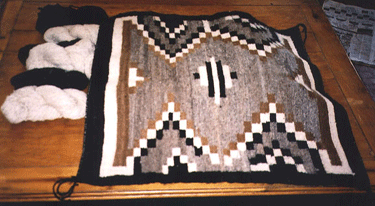
Handspun churro yarn and saddle blanket. (Photo: C.S. Halberstadt, ©2003-2005 Black Mesa Weavers for Life and Land.)
KRAKER: But despite their hardiness, by the early 1970s there were only about 400 left. That’s compared to about 240,000 of the so-called white-face sheep, like rambouillet and merino. Utah State University animal scientist Lyle McNeal explains the churros were the chief victim of the government’s livestock reduction program in the 1930s. At the time, the Bureau of Reclamation blamed the huge sheep population here for eating the vegetation that kept sediment from running into the Colorado River. They worried that would shorten the life of Lake Mead and the Hoover Dam. The solution, says McNeal, was to slaughter about 800,000 sheep.
McNEAL: To me it’s always been an American holocaust because of the spiritual nature of these animals and the sacredness to the people.
KRAKER: McNeal says government agents targeted churros because they were considered inferior.
McNEAL: It was a sheep that was considered a scrub, unimproved, and was worthless in terms of the eastern textile trade. It’s not a machine processed wool, so they wanted to push, and push, and push for the merino and rambouillet type breed, which is not the most suitable breed for hand spinning and weaving in the Navajo way.
KRAKER: McNeal first stumbled upon a handful of Navajo-churros at a California ranch in the early 1970s. But the owners weren’t raising the sheep for their wool. Rather, hunters paid top dollar to shoot the rare, four-horned rams. So McNeal began trekking into remote canyons on the Navajo reservation.
McNEAL: It was a journey that I’ll never forget. Many years, traveling in remote areas and visiting with wonderful families, particularly some of the sahnees, the elders, as they call them, in areas where in the 1930s and 1940s the federal government agents weren’t able to get to wipe out some of these old remnants.
KRAKER: McNeal speaks fondly of his mission now, but it wasn’t an easy journey. His colleagues ridiculed him for not focusing his research on new and improved breeds. He even contracted hantavirus, a fatal respiratory disease spread through mice droppings that killed a research partner. And he would travel often for weeks before spotting a single churro.
McNEAL: We would take our bedrolls, sometimes we lived on old Navajo trader food, Velveeta cheese and Vienna sausage and water. But I remember in those trips, finding bones, piles of bones, in some of the canyons where during the reduction they had been asked to bring their flocks, and then they were just shot on sight. I can still see those points in the canyons where they shot the sheep and goats. They weren’t remunerated either. Some of them never got their one or two dollar a head payback.
KRAKER: Slowly, McNeal pieced together a breeding herd. He founded a nonprofit called the Navajo Sheep Project and in 1982 he began returning rams to Navajo herders.
McNEAL: If I was stopping to get some food or get some gas, or stop at a trading post, other people there would come out and see them. The elders, they would bring their grandchildren, you know, and tears would come. ‘These are the true sheep, these are the real sheep, where have these come from?’ And questions, ‘Can we get some?’ The interest was just overwhelming.
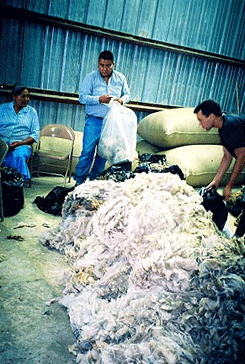
White churro wool at the wool buy. (Photo: C.S. Halberstadt, ©2003-2005 Black Mesa Weavers for Life and Land.)
[CHILDRENS’ VOICES]
KRAKER: So two small nonprofit groups have begun buying their wool at fair trade prices. At a community center on Black Mesa, Carol Halberstadt weighs laundry baskets overflowing with earthy shades of churro wool.
[HALBERSTADT ADDING UP WEIGHT OF WOOL: “PLUS 8.4, PLUS 6.8…”]
KRAKER: Five years ago, while driving on the reservation with a Navajo colleague, she was inspired to expand her mission beyond just helping weavers sell their rugs online, something she’d been doing since the early 90s.
HALBERSTADT: I was driving around Coal Mine Mesa. I saw bags of wool sitting unsold in the sun. I said ‘isn’t that churro?’ She says ‘it isn’t worth the gas money to drive it to the traders to sell, because they don’t want churro.’ I said, ‘how much are they getting?’ She said ‘maybe four, five, six cents a pound’ I said ‘what?’
KRAKER: This year, Halberstadt is paying nearly two dollars a pound for raw churro wool. Over the past four years she’s purchased and resold about 15,000 pounds of wool.
HALBERSTADT: Here’s page one…
[SOUND OF CASH BOX CLOSING, COUNTING, “50, 60, 70, 80, 90, 100”]
KRAKER: She hands the cash to Elsie Bennally who says sheep have always provided for her family.
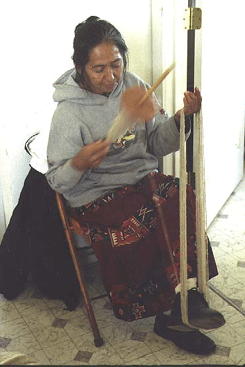
Dine' weaver skeining her handspun churro yarn. (Photo: S. Ekblad, ©2003-2005 Black Mesa Weavers for Life and Land.)
[SOUND OF SHEEP BAAAING, MOVING IN CORRAL]
KRAKER: Back at Jay Begay’s, the young weaver says he’s proud to be part of the Navajo-churro breed’s revival. But he worries the larger sheep herding tradition could disappear.
BEGAY: I remember 10, 15 years ago, where just about every house had sheep, and now about 20 percent of those people only have sheep. Just looking ahead I think 15 to 20 years, it’s going to be a lot less. It will probably be rare to see people raising sheep and herding sheep.
KRAKER: But Begay is one of several people fighting to keep the tradition alive. In November, Lyle McNeal will be back on the Navajo Nation, helping distribute another 30 churro rams – free of charge – to those committed to keeping sheep a central part of their lives.
For Living on Earth, I’m Daniel Kraker, on the Navajo reservation.
Links
Living on Earth wants to hear from you!
Living on Earth
62 Calef Highway, Suite 212
Lee, NH 03861
Telephone: 617-287-4121
E-mail: comments@loe.org
Newsletter [Click here]
Donate to Living on Earth!
Living on Earth is an independent media program and relies entirely on contributions from listeners and institutions supporting public service. Please donate now to preserve an independent environmental voice.
NewsletterLiving on Earth offers a weekly delivery of the show's rundown to your mailbox. Sign up for our newsletter today!
 Sailors For The Sea: Be the change you want to sea.
Sailors For The Sea: Be the change you want to sea.
 The Grantham Foundation for the Protection of the Environment: Committed to protecting and improving the health of the global environment.
The Grantham Foundation for the Protection of the Environment: Committed to protecting and improving the health of the global environment.
 Contribute to Living on Earth and receive, as our gift to you, an archival print of one of Mark Seth Lender's extraordinary wildlife photographs. Follow the link to see Mark's current collection of photographs.
Contribute to Living on Earth and receive, as our gift to you, an archival print of one of Mark Seth Lender's extraordinary wildlife photographs. Follow the link to see Mark's current collection of photographs.
 Buy a signed copy of Mark Seth Lender's book Smeagull the Seagull & support Living on Earth
Buy a signed copy of Mark Seth Lender's book Smeagull the Seagull & support Living on Earth

